 |
| pictures on a train to krakow. |
We were leaving for Krakow on the 8 PM train. There was a ton to see and do. We wanted to squeeze it all in. It had been five weeks we were traveling and we had four cities to go, Krakow, Prague, Amsterdam and Der Hagen.
So we packed up, finished breakfast and made our way out to
the memorable trams. On our way to the
castle, the tram took us on a detour, dropping us off at a museum recalling the
history of World War I. Number two had already
fallen in love with Sisi, the Queen of Austria during the late 19th
century. And there she was, smiling,
championing Hungry, before her assassination at the hands of an anarchist. There were the trenches where people
languished and perished. There was the
mud where people drowned. There was the Kaiser and President Wilson, who
persecuted outsiders, criminalizing sedition. There were the cousins who
allowed the splendid little war to escalate into generational suicide. There they were planning the Versailles
treaty which opened the door for the next war. History is bloody.
Finishing we ate some lunch, a delicious lunch, and looked
out at the city. It was still early and
there was a castle to see. So we made our way up to the highest point in the
city, taking the fernicular down, walked, rode the tram, looked at the old
synagogue, taking in the breathless beauty of the city, before one last trip to
the spa, where we enjoyed the afternoon before making our way out to grab our
bags. The city cemetery is right by the
train station. So we made our way. I got lost walking through the old graves
and memorials, disembodied spirits and memories, heroes from 1956 long passed,
and so many others, the vines and weeds taking them over. Looking up, I noticed I was lost. There was no map, not clear direction to find
there, just graves, weeds and labyrinth of curves and turns through the graves. I kept on wandering, hoping to find
something, snapping photos, walking until one of the security pointed me to the exit.
We still got to the train station by 7 PM in time to say
goodbye, eat some dinner, and make our 8 PM train. Simple.
Not simple. The bathroom is that
way. The food was slow. The currency needs to be changed. Forget that.
The Krakow train is at the very back of the track. So down we sprinted down, past train after
train. Is this for Krakow? It’s the one
down there, the conductors counseled, pointing down to the end of the
track. We sprinted, jumping on just in
time to wait 15 minutes for the train to really start.
The creaky train began moving, the wind blowing in my face
as we looked out at the moving landscape, the train careening into the sunset
turning to night. We looked at the landscape, tasted the wind in our
faces. And all fell to sleep.
Riding in a daze, the sound of the train, the wind blowing,
I found myself thinking of Anne Frank’s journey to Poland seven decades
prior. She’d spend most of the war
hidden away, writing her dazzling diary, only getting found out at the very
end. And they sent her to Auschwitz,
where she perished. We planned to go to
Auschwitz while in Poland. And now we were on our way, making our way East
through the night, by way of the Czech republic where the train would stop for
a bit. What must Ann have felt if she
had to stop in the middle of the night on the cattle car she was on?
By 7:30 we were arrived in Krakow. None of us had slept
much. So, we got another map,
transferred money again, and made it to our new home in the Jewish section of
Krakow, known as Kazimierz. There were
once 60,000 Jews there. Scarcely 100,000
remain today, many in Kazmiriz, the old Jewish neiborhood, across from the
Ghetto, with Arthur Schindler’s original factory. So we made our way wandering by the old town square, that Hitler had dubbed Alolf Hitler
Square after his invasion of 1939. An
old vendor was selling old Nazi and Soviet pins from the days when Poland was
part of the Rhineland. And we walked past the Jagiellonian University, where
the Nazis rounded up and send the professors to a concentration camp, there the
Jewish and elder professors perished in an event known as the Sonderaktion
Kratau. The Jewish Ghetto of Podgorze
was liquidated by the Nazis in 1943, its occupants, walled in and sent to the camps or shot in
the spot. To this day, the old
population of Jews has never come back.
Why would they knowing their neighbors send them perish? But today, the neighborhood is full of people
and remnants of the old.
I don’t care hear about Pope John Paul, who never seemed to
care about homosexuals or reproductive autonomy, although he deserves credit
for supporting the Solidarity movement against the Soviets. The Solidarity Movement was everywhere here.
So is music. We hear
a lot of this hybrid between gypsy jazz, polka, and klezmer. Everyone is in a
daze. So we stop for lunch, a nap, and the rest of the day. By the evening, the city is brimming with energy, sunlight,
people. A string quartet plays Brahms’ Hungarian Dance, the old world folk song
still full of power and old world feeling.
We drink some Tysky beer in a beer hall.
And look at the city pulsing, the polka band playing Stan Getz tunes.
Kids are playing in the park. And we all
fall in love with the majestic old city.
“It’s the first time I have ever been able to say my family
are from Polish Jews in Poland,” smiled Caroline over her beer and wurst.






































































































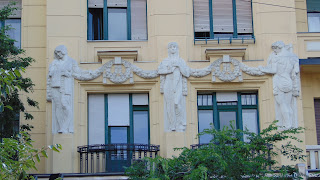










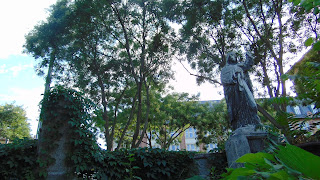


































































































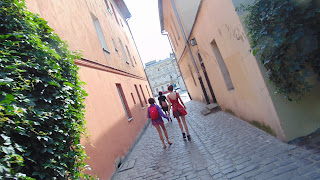
















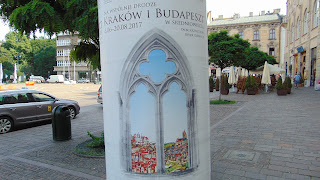


































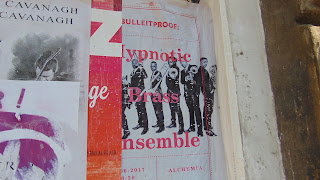

























No comments:
Post a Comment